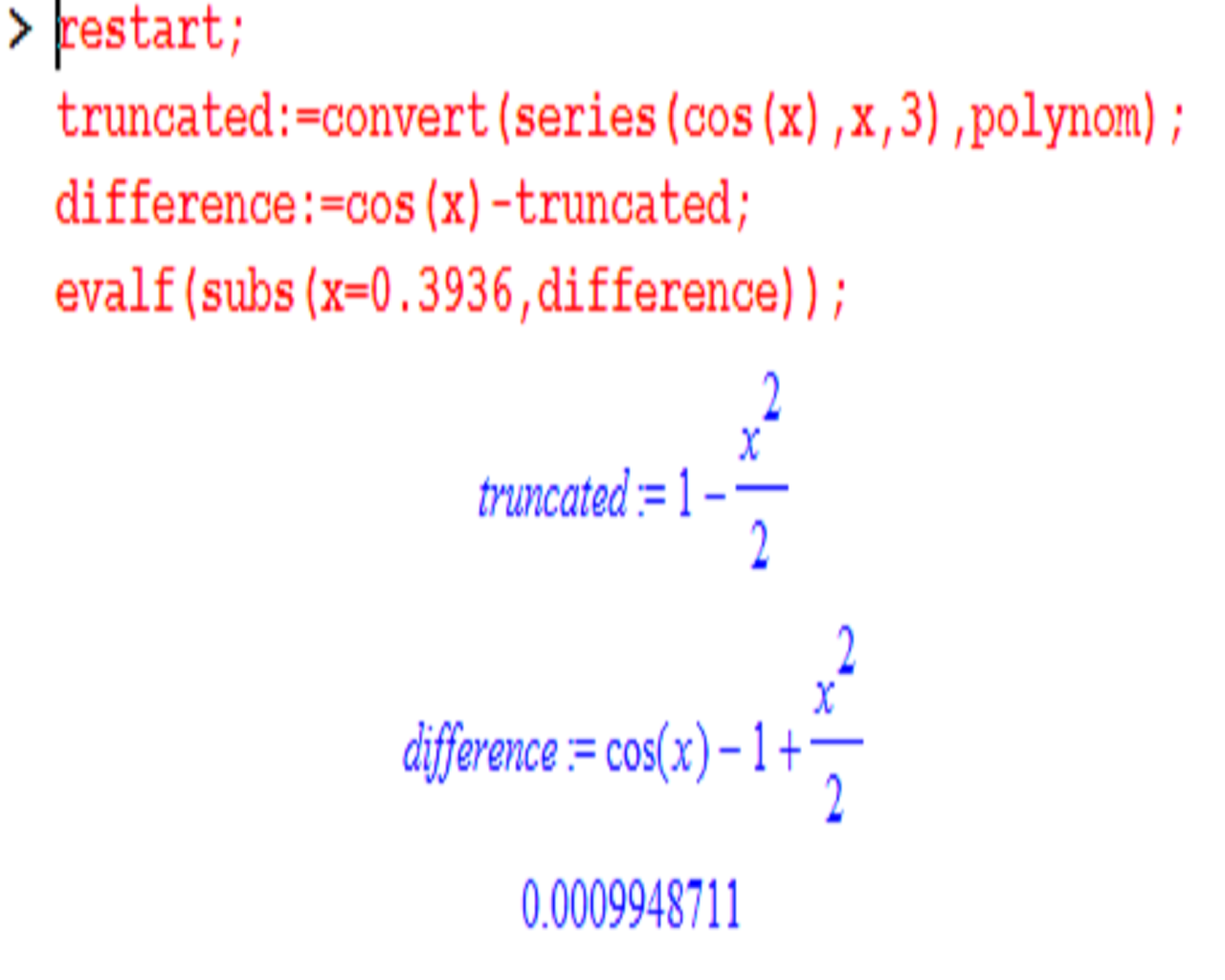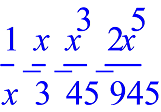4.2 HW 1
4.2.1 Section 1.1, Problem 10
4.2.2 Section 1.1, Problem 16
4.2.3 Section 1.1, Problem 24
4.2.4 Section 1.1, Problem 32
4.2.5 Section 1.2, problem 6(b,e)
4.2.6 Section 1.2, problem 7(b,c)
4.2.7 Section 1.2, problem 10
4.2.8 Section 1.2, problem 28
4.2.9 Section 1.2, problem 40
4.2.10 Section 1.3, problem 9
4.2.11 Section 1.3, Problem 11
4.2.12 Section 1.3, Problem 12
4.2.13 Section 1.3 problem 25
-
-
UP
-
-
PDF (letter size)
-
-
PDF (legal size)
4.2.1 Section 1.1, Problem 10
Problem: Prove or disprove this assertion: if is differentiable at , then for any
Solution:
Since exists, then expanding and in Taylor series results in
From first equation above we write
And from the second equation we write
equating equations (1)-(2)=0 we obtain
Keep on one side, and move everything to the other side results in
As goes to zero the above reduces to
rearrange the sign results in
4.2.2 Section 1.1, Problem 16
Problem: If the series for is truncated after the term involving and is then used to compute ,
what bound on the error can be give?
Answer:
Assume has a power series expansion around , we write, from definition of power
series
When we get
At we obtain since
Differentiate (2)
At we obtain
Differentiate (3)
At we obtain
Differentiate (4)
at we obtain
continue as above, we obtain the power series for as
Notice that for the above to converge, we need to have , or
Now if the series is truncated after , hence , and the maximum error will be the term.
Hence
which for
4.2.3 Section 1.1, Problem 24
Problem: For small values of , how good is the approximation for ? for what range of values will
this approximation give correct results rounded to 3 decimal places?
Answer:
Expand in power series, we write
expand at
At , Differentiate the above
at , Differentiate the above
at , continue as above, we obtain the series for as
Hence if we truncate the series at , then the maximum error will be bounded by
Since we want the error to be correct to 3 decimal places, then we write
Hence
Hence
So for radians (about ), the approximation give correct results to 3 decimal places.
A small code to verify:
 Figure 4.1:code
Figure 4.1:code
4.2.4 Section 1.1, Problem 32
Problem: First develop the function in a series of powers of and then use it to approximate to
10 decimal places.
Solution:
Expand at
at , differentiating the above we obtain
at , differentiate the above we obtain
at , differentiate the above we obtain
at differentiating the above gives
at
Hence the series is
Note: For convergence we require
We want accuracy to 10 decimal places. Since
Then the series, using 2 terms gives
hence 2 terms are only needed. hence
4.2.5 Section 1.2, problem 6(b,e)
Problem: For the pair , is it true that as
b)
e)
Solution:
b) Assume that hence , but since and keeps increasing, then no matter how large a we select,
will eventually become larger than any constant we choose when for sufficiently large
.
Hence there is no such , hence the answer is NOT TRUE.
e) we see that , however , hence it is not possible to find s.t. for any . Hence the answer is
NOT TRUE.
4.2.6 Section 1.2, problem 7(b,c)
Problem: Choose the correct assertion (in each,
b)
c)
Solution:
b) .
Since the limit as is not zero, hence the assertion is FALSE
c). Since grows less rapidly than then grows more rapidly than , Hence it is not possible to find
some constant s.t. , hence assertion is FALSE
4.2.7 Section 1.2, problem 10
Problem: Show that these assertions are not true:
a) as
b) as
c) as
Answer:
a) We need to
and
As the term will become larger than , hence near , since near
Therefore it is not possible to find a constant such that near since for any constant we
select, no matter how small, we can find closer to zero such that , Hence assertion is
not true.
b) The power series for is (Using CAS:).
 Figure 4.2:code
Figure 4.2:code
Here we have and
As , then
But will grow less rapidly than would as , hence it is not possible to find a constant such that
near since for any constant we select, no matter how small, can find closer to zero such that ,
Hence assertion is not true.
c) , hence
Since the limit does not go to zero, hence the assertion is not true.
4.2.8 Section 1.2, problem 28
Problem: Prove that iff
Solution:
Let
Forward direction proof:
If , then the above become
Hence , hence or or
Now proof in the reverse direction. Assume that , we need to show that this implies
If , then we can say that , where , hence
Hence
But since , then this limit does not go to zero. Hence . This complete the proof.
4.2.9 Section 1.2, problem 40
Problem: Prove: If , , and then
Answer: Since then , and since then where are positive constants.
Hence
Where
But means that is bounded above by .
But we are told next that , hence this means that the sequence will reach zero before the
sequence . But this is the same as saying that
4.2.10 Section 1.3, problem 9
Problem: Prove that if and are linear combinations of powers of and if , then
Answer: Let and
Then
4.2.11 Section 1.3, Problem 11
Problem: Give bases consisting of real sequences for each solution space.
a)
b)
c)
d)
Solution:
a) Characteristic equation is , or , hence the roots are , and or multiplicity 2.
i.e.
Hence first solution associated with is
the second solution associated with is
the third solution associated with is
Hence now we can write some terms of the above 3 basis solutions are follows
Hence the basis are
b)
Characteristic equation is , The roots are
Hence first solution associated with is
the second solution associated with is
Hence
Notice that the 2 basis are conjugate to each others in each term in the sequence.
c)
Characteristic equation is
Factoring we obtain hence the solutions are
with multiplicity 3, with multiplicity 2.
Hence Solutions associated with are
Hence , and and are also the null sequence.
Solution associated with is
Solutions associated with are
and
Hence the basis are
d)
Characteristic equation is
Hence and
Hence
and
4.2.12 Section 1.3, Problem 12
Problem: Prove that if P is a polynomial with real coefficients and if is a complex
solution of then the conjugate of , the real part of and the imaginary part of are also
solutions.
Solution:
Take conjugate of both sides
But
and all the are real, hence , then
Now take the real part of we get
But
Hence
For the last part, let
Then can be written as
But from (2) we see that hence the above becomes
Hence
4.2.13 Section 1.3 problem 25
Problem: Determine if the difference equation
Solution: Using the shift operator, we write
Hence
Hence the roots of the characteristic polynomial are or , hence
Hence and
Since , then NOT STABLE difference equation.


